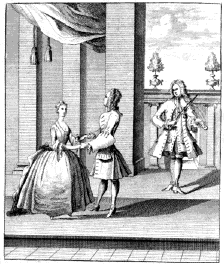

 Find us on
Facebook
Find us on
Facebook
English country dancing is done by sets of two, three, or four (sometimes even five) couples or by couples in long lines or circles of any length. Each dance consists of a fixed set of figures done to a particular tune. It is very similar to contra dancing, which is a modern American derivative. The style most often performed today comes from the work of Cecil Sharp, who recorded dances still being done in the English countryside in the early 20th century and reconstructed dances from older manuals that had fallen into disuse. Sharp published his work in a series of Country Dance Books beginning in 1909.
A name closely associated with English country dancing is Playford. In 1651 John Playford, a London music publisher, produced The English Dancing Master: or Plaine and easie Rules for the Dancing of Country Dances, with the Tune to each Dance, a collection of 105 dances and their associated tunes. Later editions, under the shortened title The Dancing Master, were published by Playford and his successors over the next 77 years. Other publishers produced their own collections well into the 19th century. These dance manuals contained vernacular dances from the countryside and more elaborate creations of the dancing masters of the time. The music came from a variety of sources from very old traditional tunes to the work of contemporary European composers. These manuals were aimed at an upper class, urban audience looking for a lively alternative to the more formal dances of the day.
There are numerous collections in use today and a good introduction is The Playford Ball by Kate Van Winkle Keller and Genevieve Shimer (1990). It includes over 100 dances as reconstructed by Sharp and later interpreters from the work of Playford and others. New dances to old and new tunes are being written still. The Country Dance and Song Society sells dance books, music, and recordings.
The Art of Dancing called by the Ancient Greeks Orchestice, and
Orchestis, is a commendable and rare Quality fit for yong
Gentlemen, if opportunely and civilly used. And Plato, that Famous
Philosopher thought it meet, that yong Ingenious Children be taught to
dance. It is a quality that has been formerly honoured in the Courts of
Princes, when performed by the most Noble Heroes of the Times! The
Gentlemen of the Innes of Court, whose sweet and ayry Activitity has
crowned their Grand Solemnities with Admiration to all Spectators. This Art
has been Anciently handled by Athenæus, Julius Pollux, Cælius
Rhodiginus, and others, and much commend it to be Excellent for
Recreation, after more serious Studies, making the body active and strong,
gracefull in deportment, and a quality very much beseeming a Gentleman. Yet
all this should not have been an Incitement to me for Publication of this
Worke (knowing these Times and the Nature of it do not agree,) But that
there was a false and surrepticious Copy at the Printing Presse, which if
it had been published, would have been a disparagement to the quality and
the Professors thereof, and a hinderance to the Learner : Therefore for
prevention of all which, having an Excellent Copy by me, and the assistance
of a knowing Friend; I have ventured to put forth this ensuing Worke to the
view, and gentle censure of all ingenious Gentlemen lovers of this
Quallity; not doubting but their goodnes will pardon what may be amisse,
and accept of the honest Intention of him that is a faithfull honourer of
your Virtues, and
Your Servant to command,
J. P.